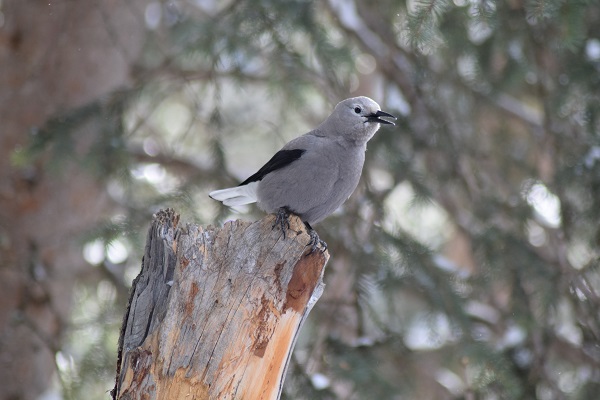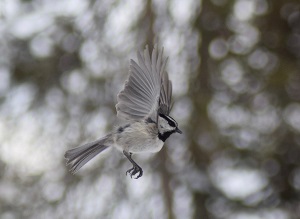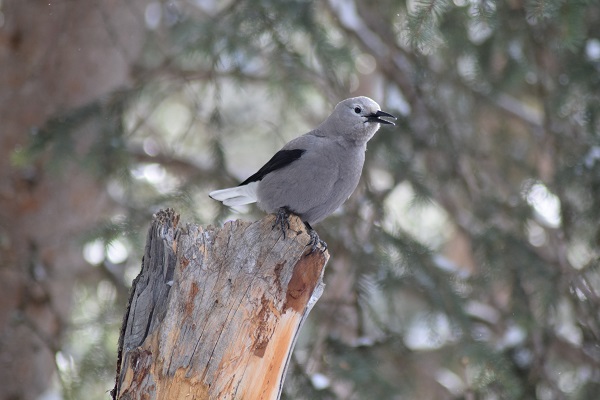
A preoccupation with the trappings of the holiday season in our human homes and places of business is both exciting and inevitable. Putting up the decorations and spending time with family and friends are things I look forward to each December. I did not grow up in an outdoors family, though of course the imagery of snow and Christmas trees was all around. Now it is 2017 and I have spent several years guiding in one of the wintriest of winter places, the Greater Yellowstone Ecosystem (GYE). As I’ve lived and worked here, the quiet intangibles of this place have become an increasingly necessary part of the season, not only for aesthetics and nostalgia, but for healing and spiritual growth. Winter is full of beauty and danger, but for me there are a few residents that embody hope, that provide a light in the dark: the winter birds of Jackson Hole.
 It is usually dark and cold around the winter solstice, so cold that your nose hairs freeze and each breath comes with a shock. The default condition of the sky is sunless, either from night or snowstorm. My outdoor time is strictly followed by hot tea and cozy blankets. Given how ill-adapted we humans are to spending time in the mountains and windy plains of Jackson Hole, it’s not a surprise that most birds leave the ecosystem in winter. They leave not just to avoid the cold, but more to avoid the lack of available food. That said, a few dozen species stay and even thrive in winter. When we stop to think about it, it’s amazing how such lightweight animals can survive in a place where, and at a time when, we humans are so dependent on technology.
It is usually dark and cold around the winter solstice, so cold that your nose hairs freeze and each breath comes with a shock. The default condition of the sky is sunless, either from night or snowstorm. My outdoor time is strictly followed by hot tea and cozy blankets. Given how ill-adapted we humans are to spending time in the mountains and windy plains of Jackson Hole, it’s not a surprise that most birds leave the ecosystem in winter. They leave not just to avoid the cold, but more to avoid the lack of available food. That said, a few dozen species stay and even thrive in winter. When we stop to think about it, it’s amazing how such lightweight animals can survive in a place where, and at a time when, we humans are so dependent on technology.
 At less than half an ounce each, you can mail two adult mountain chickadees with a single postage stamp and still have enough weight left over to include a few pages of a letter. In the hand, they seem as slight as the flame on a candle. Yet this tiny species spends the winter here, caching food in the warmer months and lowering their metabolism at night. My neighborhood mountain chickadees seem to be even more trusting than the well-known black-capped chickadee and will readily take peanuts from my hand in winter.
At less than half an ounce each, you can mail two adult mountain chickadees with a single postage stamp and still have enough weight left over to include a few pages of a letter. In the hand, they seem as slight as the flame on a candle. Yet this tiny species spends the winter here, caching food in the warmer months and lowering their metabolism at night. My neighborhood mountain chickadees seem to be even more trusting than the well-known black-capped chickadee and will readily take peanuts from my hand in winter.
 Feeding on animal carcasses is another means for gathering the roughly ten daily calories a mountain chickadee needs to survive another day. But in the field, we’re more likely to see ravens, magpies, and eagles on carcasses. Both bald and golden eagles migrate in large numbers to Jackson Hole to feed off large ungulate carcasses, and maybe to throw in a little duck hunting on the open water of the Snake River if the opportunity arises. Ravens are often dismissed because of their abundance and identical appearance, but if you spend time watching their behavior, your patient observations will be rewarded: they are intelligent, complex, social animals.
Feeding on animal carcasses is another means for gathering the roughly ten daily calories a mountain chickadee needs to survive another day. But in the field, we’re more likely to see ravens, magpies, and eagles on carcasses. Both bald and golden eagles migrate in large numbers to Jackson Hole to feed off large ungulate carcasses, and maybe to throw in a little duck hunting on the open water of the Snake River if the opportunity arises. Ravens are often dismissed because of their abundance and identical appearance, but if you spend time watching their behavior, your patient observations will be rewarded: they are intelligent, complex, social animals.
 There are two songbirds that we will occasionally hear actually singing in midwinter. As I scan across the cliffs along Slide Lake looking for bighorn sheep, I will often pick out the tumbling song of the Townsend’s Solitaire. This unassuming gray relative of the bluebird and robin will sing all winter long. While it can be surprising and charming to hear birdsong at -20 F, the bird has a serious reason to sing. It is defending its winter food source – berries – from other solitaires. Searching further down the Gros Ventre River, it would be hard to miss our other winter songster, the American Dipper, an aquatic songbird that dives headfirst in to ice cold water in search of aquatic invertebrates.
There are two songbirds that we will occasionally hear actually singing in midwinter. As I scan across the cliffs along Slide Lake looking for bighorn sheep, I will often pick out the tumbling song of the Townsend’s Solitaire. This unassuming gray relative of the bluebird and robin will sing all winter long. While it can be surprising and charming to hear birdsong at -20 F, the bird has a serious reason to sing. It is defending its winter food source – berries – from other solitaires. Searching further down the Gros Ventre River, it would be hard to miss our other winter songster, the American Dipper, an aquatic songbird that dives headfirst in to ice cold water in search of aquatic invertebrates.
 Our larger rivers and geothermally heated waters do not freeze and become homes to many species of waterfowl, including the stunning black and white Goldeneye and the majestic Trumpeter Swans. Urban dwellers frequently take the presence of swans for granted because they are so used to the invasive Mute Swan, but those lucky enough to hear the trumpeting call feel differently. Silent swans can be memorable too: one of my most unforgettable bird experiences occurred with trumpeters, as I skied along the Snake River on a snowy day. The absolute silence combined with the beauty of the massive white birds against the gray sky is a memory I will treasure for the rest of my life.
Our larger rivers and geothermally heated waters do not freeze and become homes to many species of waterfowl, including the stunning black and white Goldeneye and the majestic Trumpeter Swans. Urban dwellers frequently take the presence of swans for granted because they are so used to the invasive Mute Swan, but those lucky enough to hear the trumpeting call feel differently. Silent swans can be memorable too: one of my most unforgettable bird experiences occurred with trumpeters, as I skied along the Snake River on a snowy day. The absolute silence combined with the beauty of the massive white birds against the gray sky is a memory I will treasure for the rest of my life.
 One type of bird almost guaranteed to leave a vivid impression wherever and whenever you see it is the owl. From the elegant gray ghost (the Great Gray) to the fit-in-the-palm-of-your-hand pygmy owl, owls winter across the landscape in the GYE. Their riveting gaze can only be matched by that of the wolf; it can leave you feeling like you just received a jolt of electricity. Owl sightings are unpredictable, but they are more common than you might guess as you drive by on your first visit. The trick is to search thoroughly and patiently.
One type of bird almost guaranteed to leave a vivid impression wherever and whenever you see it is the owl. From the elegant gray ghost (the Great Gray) to the fit-in-the-palm-of-your-hand pygmy owl, owls winter across the landscape in the GYE. Their riveting gaze can only be matched by that of the wolf; it can leave you feeling like you just received a jolt of electricity. Owl sightings are unpredictable, but they are more common than you might guess as you drive by on your first visit. The trick is to search thoroughly and patiently.
 There are so many other amazing birds to encounter in the GYE winter landscape: the flash of pink on a common redpoll or a gray-crowned rosy finch on Miller Butte, a small flock of white Snow Buntings feeding on the road to Shadow Mountain, thick-beaked crossbills and grosbeaks in the subalpine firs, the blue beauty and sassy personality of a Steller’s Jay scolding you from a tree in Hayden Valley. While we may not be able to amass more than a few dozen species of birds on our annual Christmas Bird Counts, it’s the quality that counts. I can’t think of a better manifestation of the hope and joy that we associate with the holiday season than these small bundles of feather, sinew, and moxie.
There are so many other amazing birds to encounter in the GYE winter landscape: the flash of pink on a common redpoll or a gray-crowned rosy finch on Miller Butte, a small flock of white Snow Buntings feeding on the road to Shadow Mountain, thick-beaked crossbills and grosbeaks in the subalpine firs, the blue beauty and sassy personality of a Steller’s Jay scolding you from a tree in Hayden Valley. While we may not be able to amass more than a few dozen species of birds on our annual Christmas Bird Counts, it’s the quality that counts. I can’t think of a better manifestation of the hope and joy that we associate with the holiday season than these small bundles of feather, sinew, and moxie.


